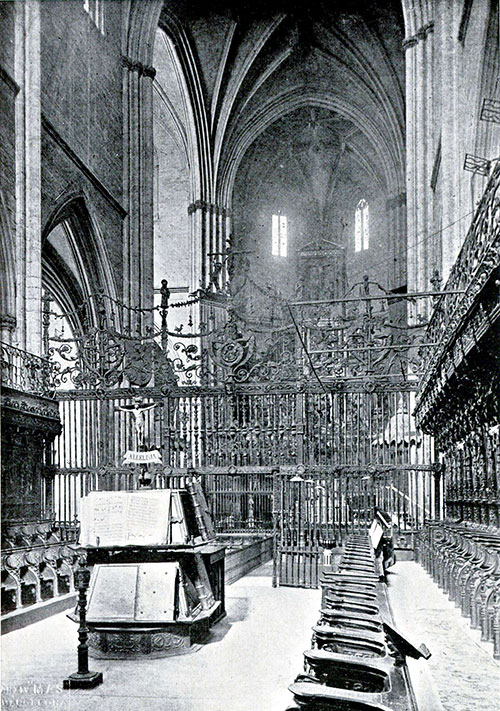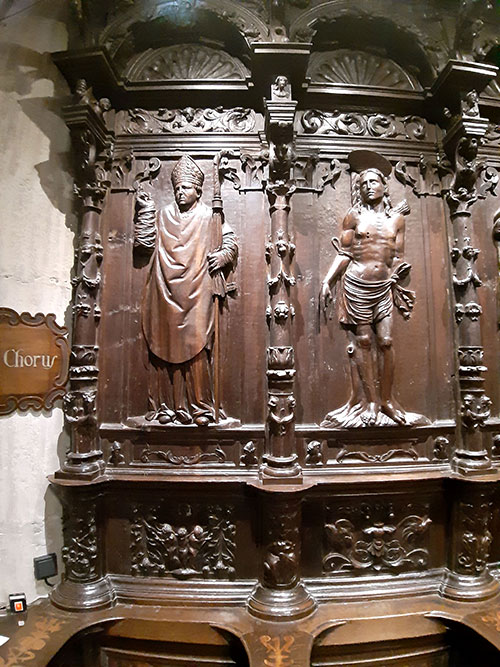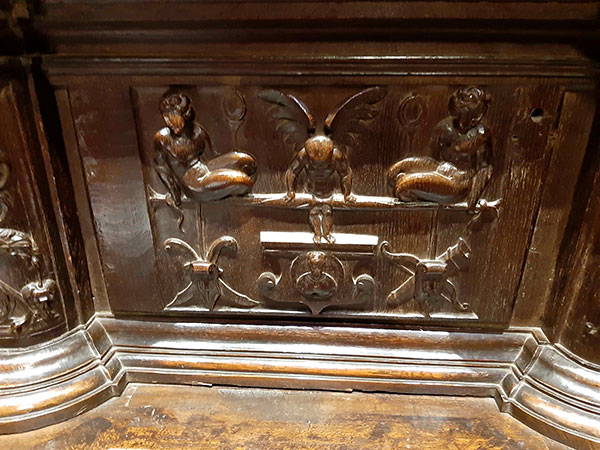21 June
Choir stalls of the cathedral of Pamplona
Pablo Guijarro Salvador
The choir stalls, executed between 1539 and 1541, represented the introduction of the Renaissance in the cathedral of Pamplona and a fundamental milestone to understand the diffusion of the style in Navarre, since masters who worked on it would contract from then on numerous works all over the country.
Unfortunately, we cannot contemplate the ensemble in its original location in the central nave. In the 1940s, liturgical motivations and stylistic restoration led to its fragmentation and relocation. Most of the chairs were taken to the presbytery, where the main altarpiece had been removed. Since there was not room for all of them, the surplus chairs were sold to the Diputación and ended up in the Museum of Navarre, where they are on display in the chapel choir. On the other hand, the grille that closed the choir area, of the same style and chronology, now stands in the chapel of the Santísimo.

Chairs in their original location
The promoter of the choir stalls was the prior Sancho Miguel Garcés de Cascante, a personality who had lived in Rome at the court of Julius II and was familiar with the spectacular development of the arts during his pontificate, in which figures such as Bramante, Raphael and Michelangelo excelled. This repeats what had already happened in the choir stalls of Tudela -the first manifestation of the Renaissance in Navarre-, whose mentor, the dean Villalón, had also belonged to the circle of Julius II.
Another point in common between both pieces of furniture is their elaboration under the direction of Esteban de Obray, considered the introducer of the Renaissance style in Navarrese sculpture. To him is attributed the rich decorative program "a la romana" of the Pamplona stalls. Of Norman origin, in this work he was surrounded by some masters of similar origin, such as Pierres Picart or Peti Joan de Beauvais, so that in the focus of Pamplona, as in other regions of Spain, the Italian Renaissance arrives with a French imprint.
The stalls had a hundred seats organized in two orders: the upper one, for the canons, with the episcopal chair as the axis of symmetry, and the lower one, for the lesser dignitaries and the other clerics. Its structure is based on the model created by Bigarny for the cathedral of Burgos. Each chair is profusely decorated: the back made of inlaid wood, the mercy, a bas-relief panel under the folding seat and four other smaller ones on the partition walls, and the curvilinear knobs, which in turn house an openwork figure and are supported by an atlantean leaning on a baluster. In the upper masonry, in addition to the above, there is a panel with the carving of a saint on a bench with grotesque decoration and a base with a cartouche between busts. The panel is flanked by balustraded columns and crowned successively by a frieze with busts on its sides and a venera. The top of the set is a canopy over figures as corbels, which also has a decorated frieze and is crowned by curved tympanums that house more busts. The result is a complex iconographic program with dozens of images dominated by a variety of profane themes inspired by the classical world.
Indeed, the humanists understood that the truths of faith could be expressed by resorting to mythology and its symbols. Thus, especially in the lower part of the masonry, divinities and mythological characters are mixed with grotesque compositions populated by classical motifs, plant stems, naked figures and monstrous beings in metamorphosis, all symmetrically arranged in candelieri. Echeverría Goñi has deciphered some of these pagan themes, although many would have no other purpose than ornamental, with its source of inspiration in engravings and drawings.

Saint Bishop and Saint Sebastian
The saints of the panels represent the idea of historical continuity of the Church. It would correspond to the sculptor Guillén de Holanda, partner de Bigarny in Burgos, who by then had participated in the cathedral stalls of Santo Domingo de la Calzada and Calahorra. They are individual figures of full body, that remain static and in serious attitude, in which Holanda sample his talent in the treatment of hair, beards and clothing. The general impression of monotony is attenuated by the large attributes that identify each saint or the variety of looks to one side or the other.

Grotesque panel with allegory of Prudence
Apart from the series of saints, the predominance of the fantastic and whimsical over the purely religious content is disconcerting for today's viewer. The excesses of this old-fashioned decorative fervor would lead to its prohibition by the Council of Trent in search of decorum and clarity of the message. The Pamplona choir stalls offer a great diversity of elaborate grotesque and mythological images, the details of which have been little divulged until now. It is a valuable iconographic richness characteristic of the early Renaissance, which shows the humanist culture of both the canons of the cathedral and the artists who worked in their service.
